Marginal land resources management
A major concern in Uzbekistan as in many other countries is the declining productivity of crops, especially of rice, cotton and wheat. This is mainly due to water-induced land degradation (salinization, sodification, waterlogging or groundwater depletion), and loss of soil fertility with the sustained removal of nutrients associated with more intensive cropping and the inappropriate use of heavily subsidized nitrogenous fertilizers.
There is usually no single way to achieve salinity control in irrigated lands and associated waters. Many different approaches and practices can be combined into satisfactory control systems; the appropriate combination depends upon economic, climatic, social, as well as edaphic and hydrogeologic situations. Thus, no procedures are given for selecting "the" appropriate set of control practices for different situations. They are too numerous.
Rather, some important goals, principles and strategies of salinity management, at both on-farm and project levels, which should be considered in the selection and implementation of control practices are reviewed and discussed.
|
AGROFORESTRY SYSTEMS ‘The World Agroforestry Centre defines agroforestry as a dynamic, ecologically based, natural resources management system that, through the integration of trees on farms and in the agricultural landscape, diversifies and sustains production for increased social, economic and environmental benefits for land users at all levels.’ Source: World Agroforestry Centre. (read more…)
|
Agroforestry has long been recognized for its potential as a stable and sustainable production system and for its potential contribution to broader agricultural systems. Agroforestry can extend the amount of time that a given area can be productive, improve livelihoods, and contribute to forest and biodiversity conservation. Constraints to agroforestry systems include: high interest rates, unclear institutional responsibilities, limiting policy frameworks, poorly developed markets, and inadequate research and extension. Support to agroforestry needs to address this broad range of issues, within flexible program designs.
Different agroforestry technologies including:
• Boundary planting. Trees are planted as living fences along field borders to provide fodder and limit soil erosion and water runoff.
• Hedgerow intercropping. Leguminous, nitrogen-fixing trees are planted in rows, interspersed with rows of crops in areas where fallow periods are not possible.
• Parkland system. Trees and crops are grown together with trees acting as a permanent upper canopy providing shade or protection from wind.
• Silvopastoral system. Trees are planted on pastureland to provide shade and forage for grazing livestock.
• Home gardens. Trees are planted for productive purposes within small plots with other crops, including vegetables, fodder, grains, herbs, and medicinal plants.
• Multistrata system. Trees and crops are interplanted with multiple tree species maturing at different rates and occupying different canopy positions.
• Improved fallow. Tree species are planted either just before or just after crops have been harvested in areas entering a fallow cycle.
• Taungya system. Trees are intercropped with other crops until the trees become mature, at which point cultivation of the other crops is abandoned.
• Relay cropping. Trees and crops are planted together with planting dates staggered such that crops mature before trees become very large at the end of the rainy season…
However, agroforestry is not appropriate in all areas, as trees take up space on a more-or-less permanent basis and may compete with crops for water, sunlight, and nutrients, thereby limiting crop production. (read more…)
Agroforestry projects can reduce poverty directly by providing lumber, fuelwood, fruit and nuts, and livestock fodder, all of which can be sold to generate income or fulfill basic family needs (see box). The sale of timber is particularly important to poverty reduction, as returns are long term. Indirectly, agroforestry can increase crop production and incomes through conservation of soils and soil moisture.
|
Benefits of agroforestry • Agroforestry plantings in Indonesia currently harbor 50 percent of the plants, 60 percent of the birds, and 100 percent of the large animals that would normally be found in a natural forest. • Cocoa agroforestry in Cameroon conserves 62 percent of the carbon found in a natural forest, and contains a plant biomass of 304 tons/hectare (compared to 85 tons/hectare in crop fields). • In southern Africa, improved fallow agroforestry systems (including species such as Sesbania) add soil nutrients equivalent to approximately US$240 worth of chemical fertilizers per hectare. • In Burkina Faso, the planting of live fences (including Acacia nilotica, Acacia senegal, and Ziziphus mauritiana) has increased farm incomes by US$40 per year. Source: World Bank 2002; Adesina et al. 2001; Sanchez, Izac, and Scott 1999.
|
Appropriate species selection is important, and varies by location depending on agroclimatic conditions, markets, and farmer experience. Species selection should also be coordinated across areas to ensure that the market is not flooded due to the overproduction of a single species. Agroforestry can have other negative effects on surrounding ecosystems if non-native tree species spread beyond the farm boundaries. Where such risks are substantial, agroforesty programs should consider the use of native species instead of exotic trees… (read more…)
|
Best practices of sustainable management of land resources are documented and posted on the website of WOCAT " https://www.wocat.net/en/network global database of soil and water saving approaches and technologies to disseminate this experience throughout the world. Since 1992 WOCAT has built up a global network of SLM (sustainable land management) specialists from over 50 partner institutions worldwide. To date, WOCAT was organized as an informal global network of national, regional and international institutions providing tools and methods that allow SLM specialists to identify fields and needs of action and to share their valuable knowledge in land resources management…. Useful links:
|
Best practices
Uzbekistan
A plantation of salinity-tolerant tree species, mostly having nitrogen fixing and high biodrainage capability, is created in a plot of arable land, out of use due to high salinity and water logging in order to restore productive functions of the land.
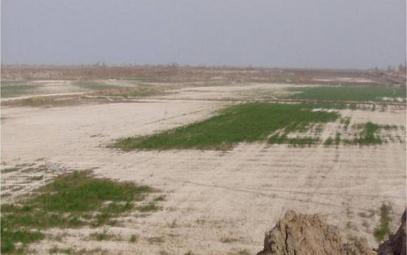 |
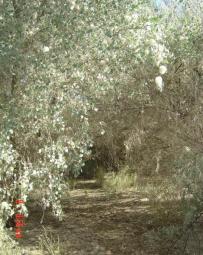 |
|
|
General view of marginal saline lands in Khorezm oblast, for which agroforestry reclamation was recommended. Salt efflorescence on the soil surface can be recognized. (Photo: A. Khamzina)
|
Seven years after forestation: tree limbs closed, there are fallen leaves and young growth under the trees. (Photo: A. Khamzina) |
Read more …
1 - Агролесомелиорация деградированных пахотных земель (UZB004r) http:// cdewocat. unibe. ch/ wocatQT/ qt_ summary. php? lang= Russian& qt_ id=622
2 - Agro forestry reclamation of degraded arable lands (UZB004e)
http://cdewocat.unibe.ch/wocatQT/qt_summary.php?lang=English&qt_id=626
(2) Improvement of land under arid conditions through the creation of pistachio plantations
This technology is aimed at the creation of pistachio plantations on gentle slopes to improve the land’s productivity and to rehabilitate the arid land in the hill zone…
 |
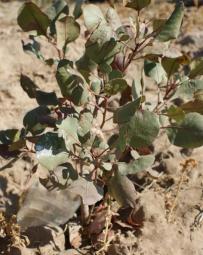 |
|
|
Pistachio plantation is created on a part of rainfed field. Seedling planting spots are marked with pegs. (Photo: A. Volkov) |
Seedlings are irrigated using plastic bottles. After 2 years, irrigation is stopped and trees consume the natural precipitation. (Photo: A. Volkov) |
Read more …
1 - Улучшение земель в аридных условиях через создание фисташковых сортовых плантаций (UZB001r) http://cdewocat.unibe.ch/wocatQT/qt_summary.php?lang=Russian&qt_id=614
2 - Improvement of land under arid conditions through creation of pistachio plantations (UZB001e)
http://cdewocat.unibe.ch/wocatQT/qt_summary.php?lang=English&qt_id=623
Tajikistan
(1)
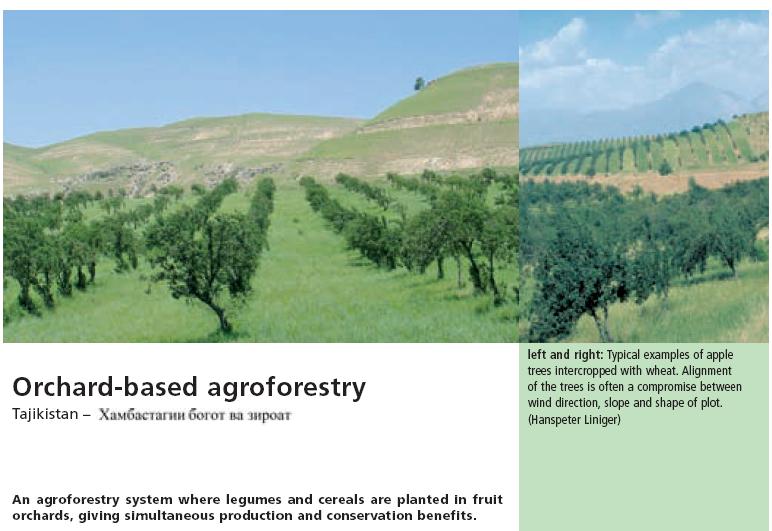
Read more… Where the land is greener , WOCAT book, Part 2.2, p.197
(2)
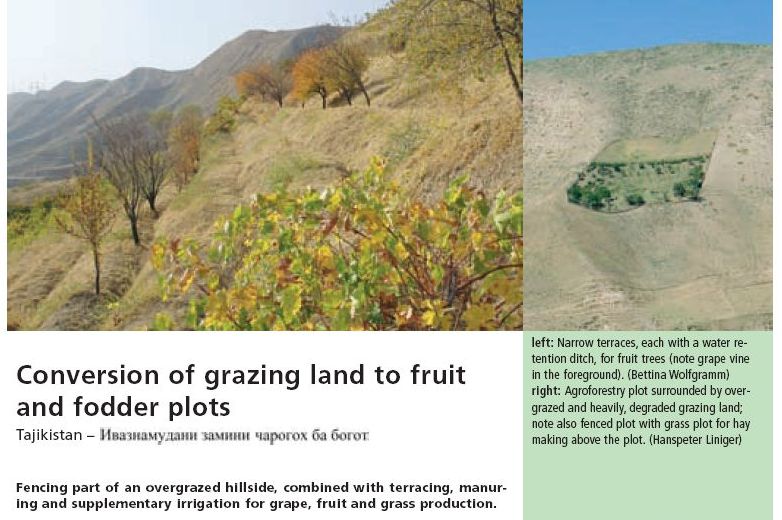
Read more… Where the land is greener , WOCAT book, Part 2.2, p.189
(3)
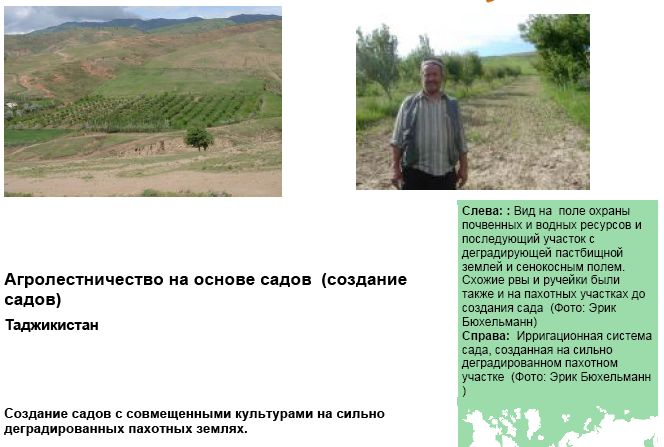
Read more … Технологии и подходы устойчивого управления земельными ресурсами. Таджикистан. WOCAT . 2011. C . Taj 008. r -1
(4)
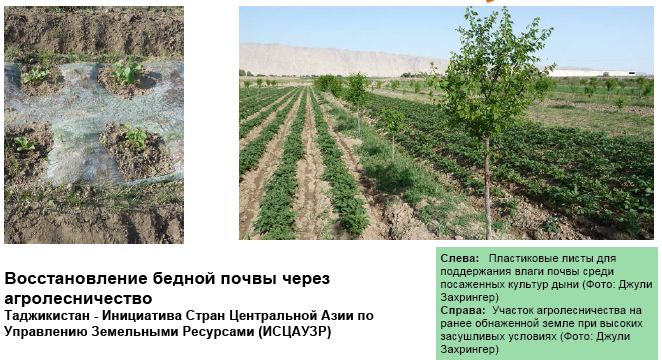
Read more … Технологии и подходы устойчивого управления земельными ресурсами. Таджикистан. WOCAT . 2011. C . Taj 113. r -1
Under the UNDP and ICACLRM project, an agroforestry system with peach, plum, cherry and persimmon trees was created on 6 ha of an abandoned land of a farmer with a poor quality of soil (in the conditions of drought and salinity). The soil fertility on this parcel of land was improved by using a set of comprehensive measures – leaching of soil before sowing to reduce the amount of salt; retaining soil moisture by using plastic sheets; prevention of excessive drainage of water and protection with the help of forest shelterbelts made of white poplars (Populus alba); increasing production diversity by planting various trees, vegetables and various crops; application of annual crop rotation…
Every 4 years, 40 tonnes of cow manure was used per 1 ha of land. The use of organic compost is an important factor of expenditures for a family, since the cost of 40 tonnes of manure varies from 180 to 220 US dollars. To improve soil moisture and possibility of early sowing of melons , seeds were sown under a tight plastic sheet with irrigation water under it. Holes were made on plastic sheet as soon as seeds sprouted in order to ensure space for the plant. Irrigation was applied scantily just to prevent new growth in soil salinity level. The parcel is located on a moderate slope, which makes easy the creation of a drainage system by digging a trench at the foot of the field to absorb excessive water. Wild olives (Elaeagnus angustifolia) from Russia were planted at the foot of the field to spread biodrainage so that to prepare neighbouring lands for conservation as agroforestry at later stages.
This technology is suitable for all arid areas, and economic benefits cover with a high surplus the costs of its creation and maintenance.
(5)
Restoring pastures by sowing the seeds of perennial shrub prostrate summer cypress. Tajikistan . Project to develop communal farming and water resources management (PDCFWRM). As part of the project ways of developing saline degraded lands on mountain slopes and restoring pastures were demonstrated.
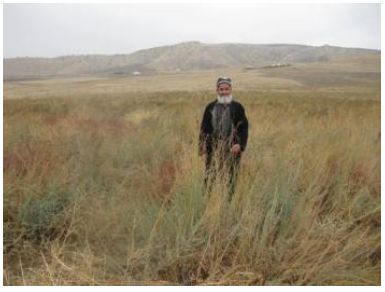 |
Seeds of prostrate summer cypress were sown on this saline parcel of land in February. Above is the picture of 10-month old prostrate summer cypress. ( Safarov T . S .) Read more … Технологии и подходы устойчивого управления земельными ресурсами. Таджикистан . WOCAT . 2011. C . Taj 368. r -1 With the support from the project and on the initiative of a local community, idle land plots in the Lokhur community of Dangara District were chosen to sow "Kuykanak" variety of prostrate summer cypress (Kochia) on 5 ha of land. The main goal of the project was to improve the condition of pastures, to prevent wind and water erosion by sowing semishrub prostrate summer cypress at the 100-percent sprouting with sowing rate of 6-8 kg per hectare. To save fuel and financial costs, 25-30 cm deep ploughing and harrowing were done simultaneously. Seeds of semishrub prostrate summer cypress were sown at the depth of 0.5-1.0 cm. After the sowing the area was fenced with metal enclosure. Average lifespan of prostrate summer cypress is 25-30 years. Prostrate summer cypress is mainly used to enrich parched pastures. Biological value of prostrate summer cypress is the fact that it tolerates well hot summer days of southern Tajikistan. At the same time prostrate summer cypress is a resilient crop of eastern Pamir, where air temperature drops down to 40-45 Celsius below zero in winter time. |
DRAINAGE
|
Drainage is the natural or artificial removal of surface and sub-surface water from an area. Many agricultural soils need drainage to improve production or to manage water supplies. An agricultural drainage system is a system by which the water level on or in the soil is controlled to enhance agricultural crop production. Agriculture drainage is mainly of two types: (1) Surface drainage; (2) Sub Surface Drainage. However there are some other drainage systems also. (Read more …) |
Best practices
Uzbekistan
Intensive development of saline lands or irrigated lands affected by salinity is possible i f drainage system is constructed and leaching mode of irrigation is created . At that it is expedient to create descending flow of irrigation water at the expense of water-charging irrigation during the off-season. Dates and rate of water-charging irrigations should be set based on forecast of salinity level of irrigated lands taking into account natural and farming conditions...
When water-charging irrigations are carried out in the conditions of the arid climate, soil moisture is lost through evaporation and there is some accumulation of salt in the soil by the beginning of the next growing season. Therefore in many cases it is advisable to do spring water-charging irrigations …
The results of calculations show that optimal meliorative mode in the conditions of Kanibadam (Central Kyzylkum) is ensured by deep drainage 3.5-4.0 m with a groundwater table at 2 to 2.8 m … (Ergash Karimov , 1974, read more…)
The condition of irrigated lands depends on the availability of a drainage system in the territory. It is shown that intensive salinity control is ensured in areas with a horizontal drainage system where distance between drains is 100, 200 and 400 m. During one cycle of crop rotation of rice the reserves of salt at the depth of 0-3 m of soil accordingly decreased from 342.8 down to 36.1 t/ha, from 359.7 down to 42.3 t/ha and from 347.9 down to 45.4 t/ha or 9.5, 8.4 and 8.1 times. Areas with high salinity level have practically become not saline thanks to the operation of the drainage system… During this period in areas with closed horizontal drainage system with distance between drains 600 m, soil salinity at the depth of 0-3 m remained 111.8 and 185.2 t/ha… ( Kruglov L.V. , 1985, read more … )
To ensure irreversible desalinazation of soil and demineralization of groundwater, leaching mode of irrigation should be ensured during the year within the following irrigation rates (net): … 7.7-8.3 thousand. m 3/ha annually (2,500-3,500 m 3/ha for autumn-winter leaching) for moderately and highly saline soils; in these cases the amount of desalinizing discharge of water varies from 600 up to 2,900 m3/ha, and the removal of salts from the aeration zone is 2.2-15.0 t/ha annually … (Bekmuratov T .U, 1983, read more…)
BIODRAINAGE
|
What is new? Biodrainage controls excess water by using the water uptake capacity of vegetation, especially trees. Its potential is greatest in arid climates. India, Australia, and other countries have demonstrated that tree plantations can help control shallow water tables and reclaim waterlogged areas. But biodrainage removes more water than it does salts. Salts accumulate when water is mineralized unless salt balances are maintained by natural or artificial drainage. Biodrainage can assist but generally not replace conventional subsurface drainage for salinity control of irrigated land. (read more… )
|
Unlike conventional drainage, biodrainage does not need ditches, canals, pumps, or other physical means to collect and transport excess water. Nor does disposal of drainage effluent present a problem. Capital and O&M costs are restricted to the costs of establishing and maintaining the plantations. Biodrainage is not yet practiced on a sufficiently large operational scale to permit cost comparisons with conventional drainage.
Interest in biodrainage is strong in Australia, where it is considered an environmentally attractive option to restore water balances disturbed by past changes in land use, and in China, India, and some arid developing countries that see biodrainage as a low-cost option for combating waterlogging and salinization of irrigated land.
Biodrainage is best achieved by planting tree species that are heavy consumers of water and also tolerant of waterlogged and saline conditions. Planting in belts and blocks is most common and also most effective. Trees have also been planted in narrow strips of three or more rows, resembling pipe- or ditch-type field drainage systems. These strips also act as windbreaks. Biodrainage is best suited to combat waterlogging that is localized, as along canals, not area wide.
Suitable Species
Trees generally have extensive and deeply penetrating root systems and high aerodynamic roughness. These features make them better biodrainage performers than bushes, but bushes outperform crops. A tree plantation normally evapotranspires 25 to 50 percent more water than a cropped area. Eucalyptic species are widely used, but good experiences have also been recorded with Acacia, Prosopsis, and Tamarix spp. Poplar and willow spp are used in north China. Plantations may have one or more species, sometimes with an undergrowth of resistant bushes or crops. Source: IPTRID 2002.
Biodrainage design requires a good understanding of local hydrology and the causes and nature of the waterlogging problem. Waterlogging in depressions and valley bottoms may be addressed by planting in the affected areas, in the upslope source areas, or wherever the plantations intercept seepage flows.
Biodrainage plantations will also take up and remove salts with the harvested products , but usually too little salt is removed to maintain salt balances. Biodrainage in the arid zone is therefore generally sustainable only when salt accumulation in the root zone is minimal as a result of efficient irrigation with high-quality water or when natural or supplemental artificial drainage removes a sufficient amount of salt from the root zone. On the downside, where water is scarce biodrainage may evaporate water that could be used more beneficially…
|
Sequential Biological Concentration Plants may be used to concentrate saline drainage water to facilitate its disposal. If small in scale, this solution is feasible where evaporation ponds or other regular means of disposal cannot be used. Biological concentration has been piloted in the San Joaquin Valley, California. The subsurface drainage effluent from land planted with regular crops and halophytes (salt tolerant crops, trees, and bushes) is sequentially reused and finally released into a small evaporation pond. Each next reuse area is only a fraction of the source area. In the process, the drainage water is reduced in volume, but its salt concentration increases to end up in solid form in the evaporator. ( read more…) Source: USBR 1999.
|
Best practices
Kyrgyzstan

Read more… Where the land is greener, WOCAT book, p.165
India
In the Indira Gandhi Nahar project in India, eucalyptus and acacia plantations reclaimed seepage zones along leaking irrigation canals and waterlogged depressions. The best approach was to start planting trees away from the most affected areas and move toward these areas by the time the first areas had somewhat dried out. Reclamation took only a few years. The plantation water tables reached depths of 15 meters in six to seven years, and the root systems were 10 meters deep. Biodrainage has worked well in a variety of other situations… (Read more…)

